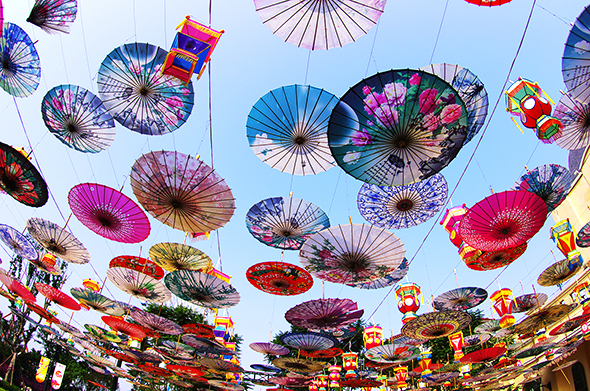Passing umbrellas to the next generation

Traditional stories have imbued oiled-paper umbrellas with romantic overtones.
“Alone holding an oiled-paper umbrella,
I wander along a long
Solitary lane in the rain,
Hoping to encounter
A girl like a bouquet of lilacs
Gnawed by anxiety and resentment.”
The poem A Rain in the Lane, written by modern Chinese poet and translator Dai Wangshu (1905-50), gave many Chinese people a romantic image of oiled-paper umbrellas. But Dai was not the first to have imbued these umbrellas with romantic overtones.
The Legend of the White Snake is one of China’s most famous folk tales. As the legend goes, Madam White Snake came to the human world in search of companionship. She married a scholar named Xu Xian, after the two had a romantic moment under an oiled-paper umbrella on a rainy day by the famous landmark West Lake.
Of course, these umbrellas were created for more than just romance.
In Fengshuiling Town, far away from the urban areas of Luzhou City, Sichuan Province, an old workshop still stands on the street after 400 years. This is the Fengshui Umbrella Factory. The unique factory uses hand-made tung oil and lithographic techniques to make oiled-paper umbrellas. In 2008, Fengshui oiled-paper umbrellas were recognized as a type of national intangible cultural heritage.
This move came after concern that the skills required to create these ancient tools were dying out.
Based on local records, Fengshui oiled-paper umbrellas originated sometime during the late Ming Dynasty or the early Qing Dynasty. But with the rise of nylon folding umbrellas and cloth umbrellas in the 1970s, many hand-made oiledpaper umbrella factories closed down. The Fengshui Umbrella Factory is the only one still sustaining its business.
In recent years, people’s living conditions have improved rapidly and the demand for oiled-paper umbrellas has increased in the urban areas of South China, such as Chengdu and Hangzhou. Young people have become an emerging group of consumers.
However, many challenges have emerged. The current market situation demands that these traditional manufacturing skills be integrated with modern innovative methods.
In addition, the lack of craftsmen inheriting these skills and the lack of funds are both additional challenges for the oiled-paper umbrella industry.
